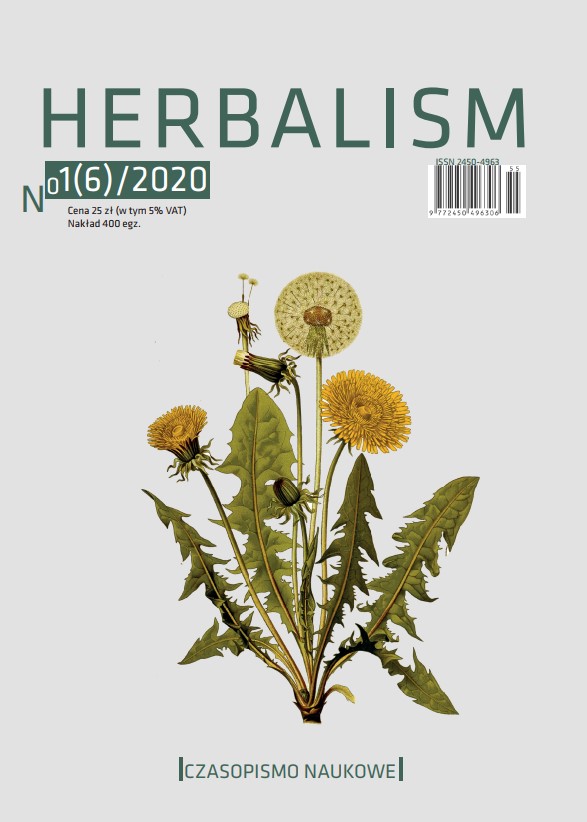Comparison of the quality of mint teas available in the retail network
DOI:
https://doi.org/10.12775/HERB.2020.003Abstract
Mint herb, commonly used in traditional medicine, is mainly consumed in the form of teas. Mint is characterized by antioxidant, antibacterial, hypoallergenic and immunomodulatory effects, as well as is benecial to the digestive tract. It is an excellent cholagogue, low diastolic, carminative and appetite stimulant. Used in the form of inhalation against runny nose, pharyngitis and bronchitis, it works weakly antiseptic. The aim of this study was to evaluate and compare the quality
characteristics of selected mint teas from diferent producers. 19 peppermint teas, in bags and without bags, were tested. Color measurements of dried leaves were made and the qualitative and quantitative analysis of the main polyphenolic compounds in 50% methanol extracts by high-performance liquid chromatography. In addition, the content of major polyphenolic compounds in aqueous infusions was determined. Based on the results obtained, it was found that mint teas difer significantly from each other. It was observed that leaf teas have higher quality than teas in bags.
References
Grigoleit H.G., Grigoleit P., Peppermint oil in irritable bowel syndrome, Phytomedicine, 2005, 12, s. 601–606.
McKay D.L., Blumberg J., A review of the bioactivity and potential health benets of peppermint tea (Mentha piperita L.), Phytotherapy Research, 2006, 20, s. 619-633.
Volák J., Stodola J., Rośliny lecznicze, Polska Ocyna Wydawnicza „BGW”, Warszawa 1992.
Fatiha B., Madani K., Chibane M., Duez P., Chemical Composition and Biological Activities of Mentha Species, [w:] Aromatic and Medicinal Plants - Back to Nature, Hany A. El-Shemy, IntechOpen, 2017, DOI: 10.5772/67291.
Lawrence, B.M., Mint: e Genus Mentha; CRC Press: Boca Raton, FL, USA, 2006.
Salehi B., Stojanović-Radić Z., Mateji, J., Sharopov F., Antolak H., Kręgiel D., Sen, S., Shari-Rad M., Acharya K., Shari-Rad R., Martorell M., Sureda A., Martins N., Shari-Rad J., Plants of Genus Mentha: From Farm to Food Factory, Plants 2018, 7, s. 70.
Najda A., Skład chemiczny i działanie przeciwutleniające ekstraktów z Mentha X piperita L., Postępy Fitoterapii 2017, 4, s. 251–258.
Sokół-Łętowska A., Kucharska A.Z., Wińska K., Szumny A., Nawirska-Olszańska A., Mizgier P., Wyspiańska D., Composition and antioxidant activity of red fruit liqueurs, Food Chemistry, 2014, 157, s. 533–539.
Riachi, L.G., De Maria C.A.B., Peppermint antioxidants revisited, Food Chemistry, 2015, 176, s. 72–81.
Pereira O., Cardoso S., Overview on Mentha and ymus Polyphenols, Current Analytical Chemistry, 2013, 3(9), s. 382–396, DOI: 10.2174/1573411011309030008.
Newerli-Guz J., Kobylańska A., Ocena jakości jednoskładnikowych herbatek ziołowych na przykładzie Mentha piperita, Problemy Higieny i Epidemiologii, 2013, 94, s. 862–865.
Joubert E., Manley M., Maicu C., de Beer D., E{ect of Pre-drying Treatments and Storage on Color and Phenolic Composition of Green Honeybush (Cyclopia subternata) Herbal Tea, Journal of Agricultural and Food Chemistry, 2010, 58(1), s. 338-344, DOI:
1021/jf902754b.
Downloads
The publisher's shop:
Published
How to Cite
Issue
Section
License

This work is licensed under a Creative Commons Attribution-NoDerivatives 4.0 International License.
Stats
Number of views and downloads: 596
Number of citations: 0



